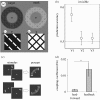Neural correlates of the contents of visual awareness in humans
- PMID: 17395576
- PMCID: PMC2430003
- DOI: 10.1098/rstb.2007.2094
Neural correlates of the contents of visual awareness in humans
Abstract
The immediacy and directness of our subjective visual experience belies the complexity of the neural mechanisms involved, which remain incompletely understood. This review focuses on how the subjective contents of human visual awareness are encoded in neural activity. Empirical evidence to date suggests that no single brain area is both necessary and sufficient for consciousness. Instead, necessary and sufficient conditions appear to involve both activation of a distributed representation of the visual scene in primary visual cortex and ventral visual areas, plus parietal and frontal activity. The key empirical focus is now on characterizing qualitative differences in the type of neural activity in these areas underlying conscious and unconscious processing. To this end, recent progress in developing novel approaches to accurately decoding the contents of consciousness from brief samples of neural activity show great promise.
Figures




References
-
- Barnes J, Howard R.J, Senior C, Brammer M, Bullmore E.T, Simmons A, David A.S. The functional anatomy of the McCollough contingent colour after-effect. Neuroreport. 1999;10:195–199. doi:10.1097/00001756-199901180-00037 - DOI - PubMed
-
- Beck D.M, Rees G, Frith C.D, Lavie N. Neural correlates of change detection and change blindness. Nat. Neurosci. 2001;4:645–650. doi:10.1038/88477 - DOI - PubMed
-
- Beck D.M, Muggleton N, Walsh V, Lavie N. Right parietal cortex plays a critical role in change blindness. Cereb. Cortex. 2006;16:712–717. doi:10.1093/cercor/bhj017 - DOI - PubMed
-
- Bodis-Wollner I, Bucher S.F, Seelos K.C. Cortical activation patterns during voluntary blinks and voluntary saccades. Neurology. 1999;53:1800–1805. - PubMed
-
- Bristow D, Haynes J.D, Sylvester R, Frith C.D, Rees G. Blinking suppresses the neural response to unchanging retinal stimulation. Curr. Biol. 2005;15:1296–1300. doi:10.1016/j.cub.2005.06.025 - DOI - PubMed
Publication types
MeSH terms
Grants and funding
LinkOut - more resources
Full Text Sources

